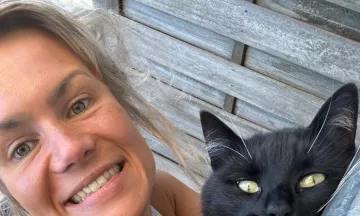Why is it so hard to give a pet medicine?
Some pets are more relaxed than others when taking medicine, however, it’s very common for pets to dislike this experience. Although you know it’s important for them, they don’t understand this fact! A cat or dog might hate the texture, smell or taste of their medicine, or simply dislike being forced to swallow something. They might even have negative associations with vet visits or not like being handled around the mouth.
Regardless, all pets need to take medication every now and then. As such, it’s helpful to learn how to administer it! Rest assured that this is a skill that gets much easier with practice.
Here are some tips and tricks to make your life (and your pet’s life!) much easier and more comfortable when giving medicine.

Tips for giving medicine to a dog or cat
Hiding pills, tablets or capsules in your pet’s food
If your vet says it’s ok for your pet to have the medication with food, this method is a possible option for some pets. Give your pet something they love to eat (check with your vet about what is safe to combine with the medication) around the time when they are hungriest.
The faster your pet gobbles the food down, the less likely they will notice any flavour. As such, bite-sized food often works well - such as a spoonful of wet food. Be sure to make sure your dog or cat has fully swallowed the pill and hasn’t spat it out, as their keen sense of smell may give the game away. For this reason, giving a pill directly is usually a safer bet to ensure your pet has taken its medicine. Read on for more info on how to do that...

Giving your pet medicine directly
This is sometimes necessary if your pet can’t have food with their medication, or if they can tell you’re hiding something in their treats (which is quite likely!). The best way to learn how to feed your pet oral medication is to book a vet visit so they can show you how: you will most likely be with them when they prescribe your pet’s medication in the first place.
Give your pet their medicine at a regular time, as part of their routine: such as when they eat dinner, if possible. And, of course, include lots of praise and encouragement.
If your pet is very resistant at first, try wrapping them gently in a towel like a burrito and position yourself behind them so that when they back up, they press into you. It’s worth getting another person to help you if this is the case.
Pills, tablets and capsules
Here is a great demonstration of giving a pill to a dog, and giving a pill to a cat. Be sure to speak to an expert before trying it yourself.
Some handy tips:
- Dip the pill into some wet pet food before you give it to them so that it’s a pleasant experience.
- Gently tilt their head at a slight upward angle (this will naturally make their lower jaw open). Pop the pill onto the very back of their tongue, and gently hold their jaw closed for three seconds to ensure they have swallowed. It can help to stroke under the chin to encourage swallowing.
- Use a ‘piller’ or similar tool to make life easier if your pet refuses the pill. You can buy one of these from most big pet suppliers.
- If possible, give your pet a treat immediately after.

Liquid medication
Depending on your pet, liquid medication might be quicker and easier than a pill. Much like pills, it’s worth discussing how to do this with your vet. They should also give you a pet syringe or recommend one to get the dosage amount right. Read the instructions on the medication carefully, and be sure to store it at the right temperature.
Here is a video with a demonstration of giving liquid medication to pets.
Some handy tips:
- Avoid tilting the head back with liquid medications or rushing the liquid, as this could cause the liquid to go down the windpipe.
- Squirt the medication into the side of the mouth between the cheek and the teeth and stroke your pet’s neck to encourage swallowing.
- If possible, give your pet a treat immediately after their medicine.
- Note that cats sometimes naturally drool and foam at the mouth if they taste something bitter. If this happens, open their jaw gently and aim for the back third of the tongue next time, as they have fewer taste buds here.
If worst comes to worst and your pet absolutely refuses to take their medication, speak with your pet’s veterinarian. They will be able to check if there is something else underlying the refusal and make sure that your pet gets its medicine.
And remember, like all things, practice makes perfect: so don’t worry if it takes a few tries or is a bit messy at first!






